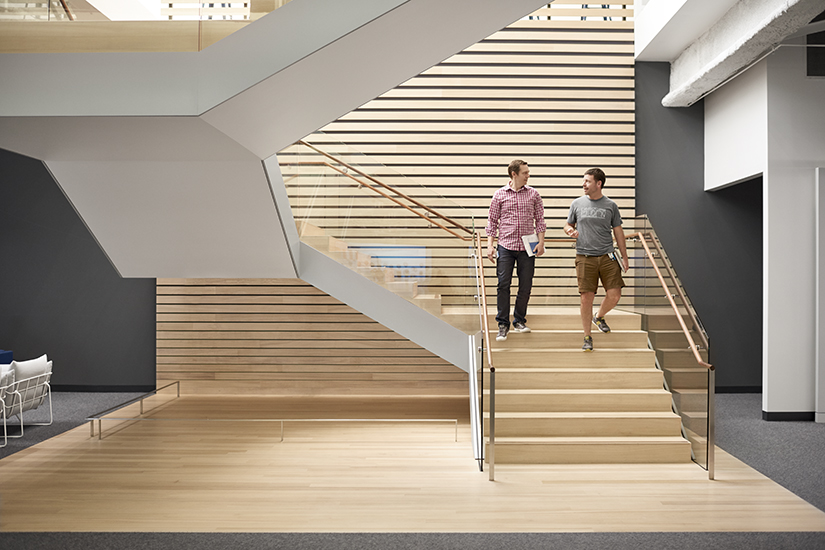For Chris Gorman, of financial-technology company Square Inc., community is the tie that binds when it comes to office design. There’s the community of Square’s employees and sellers, the community beyond Square’s offices that has to connect to the people working inside, and the overall community of the company as a whole.
It makes sense, then, that Square’s offices are designed in “a human-centric manner,” as Gorman, the company’s global real estate and workplace lead, puts it. It is, in other words, a manner in which community can be showcased.
“When we looked at our San Francisco space, we really wanted to reinforce who we are as an organization, to reinforce our values, and to connect with our sellers and with each other,” Gorman says. “You start there and start working through design considerations.”
Square, based in San Francisco, has made card transactions accessible for businesses of all sizes. Founded in 2009 by Twitter creator Jack Dorsey and Jim McKelvey, its purpose is to foster economic empowerment. Gorman started with the company six years ago, when it had 300 employees and just two offices. In the nine years since, though, it has grown to 2,000 employees, in offices in the US, Canada, the UK, Ireland, Japan, and Australia.

Before Square, Gorman worked in retail for apparel and technology, but he says his latest employer has provided him with a first opportunity to use his experience and skill to rethink office space. Today, working internally with Square’s external design partners, including Bohlin Cywinski Jackson, Gorman and his team help ensure each of the company’s new offices meets the needs of those who work there, inspires those who use it, and acts as a canvas to feature Square’s sellers and communities.
The company’s initial San Francisco office has provided the template that it continues to follow in its other offices to this day. The first phase of the San Francisco office was completed in 2013, but it has gone through multiple expansions and today spans six floors, with spaces ranging from 25,000 to 100,000 square feet. To help employees navigate the sizeable office, its design resembles a city grid, with a central boulevard and glass-paneled conference rooms named for local streets.
The office also includes dedicated spaces for local Square sellers. Anchoring two of the main floors’ boulevards, for instance, are Andytown Coffee Roasters and Wise Sons Delicatessen. “We thought it would be a great opportunity to learn from a local seller by having them inside our space and being able to interact with them,” Gorman says. The company invites other local Square users in for a variety of pop-up opportunities, including Seller Wednesdays, in which the culinary team brings in food vendors to set up shop during lunchtime.

“Traditionally you look at an office as primarily a place to do work, and you have this natural barrier, these four walls that surround you,” Gorman says. “One of the things we wanted to challenge ourselves to do was be more connected with the community. Even with these four walls, it was easy to reimagine that and invite our sellers into this space.”
Other points of interests surround the office’s central boulevard, too, including a spotlight wall where the company partners with various internal community groups to design an inspiring installation each month. Another notable feature is the grand staircase, which climbs three floors, and Maya Angelou’s poem “Rise” was recently installed on its risers. “It’s another example of how we use another architectural piece of the office to highlight who we are,” Gorman says.
Square’s other global offices similarly reflect their local settings because, as Gorman explains, imprinting San Francisco on a London office, for example, wouldn’t be the best way to tell that community’s story. Although the offices are individualized, they are still organized so that Square’s employees can settle in easily. It’s the number one compliment from employees.
“When people travel from one office to another,” Gorman says, “they can simply open their laptop and get to work.”


